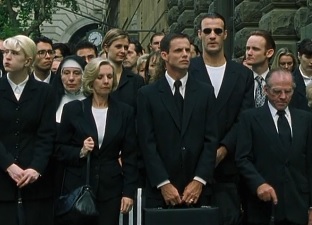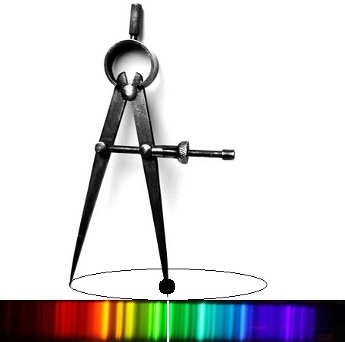 I watched an interview to Anna Marchesini recently, who made me think a lot. Anna is a famous italian comedian, who had a long and successful career in my country. She made an entire generation laugh, with her funny parodies and weird characters. She is really loved here, and I love her too. I have a big respect for comedy as art. In fact, I hope to become a successful comedian too, one day.
I watched an interview to Anna Marchesini recently, who made me think a lot. Anna is a famous italian comedian, who had a long and successful career in my country. She made an entire generation laugh, with her funny parodies and weird characters. She is really loved here, and I love her too. I have a big respect for comedy as art. In fact, I hope to become a successful comedian too, one day.
But Anna Marchesini is not only laughs and fun, she went through, and is going through, difficult moments in her life. She has been hit by a severe form of rheumatoid arthritis that really shows in her appearance today. She still has a heartwarming smile and a special light in her eyes, but her face looks hollow and bony. She has deformed hands that she elegantly hides with gloves when she’s on tv. It’s not difficult to guess that this disease gives her severe limitations. More than once she said that she’s fighting to stay alive.
In the interview, while chatting humorously and talking about the first book she published, the interviewer pointed out how she was mixing together comedy and tragedy in the same novel, without a defined point where one was starting and the other was ending. He said that almost using a surprised tone, because most people would only expect lightness and humour from Anna. After all, these are the only parts of her they have seen for a lifetime.
 Without ceasing to radiate energy for a moment, she replied: “I think that somewhere emotions stand all together, like in a magma.” She said that rolling her hands in the gloves, suggesting the image of a magma made of emotions, one rolling over the other in a continuous movement. Joy rolling over despair on top of the fluid, and then down again to switch positions, and then up again.
Without ceasing to radiate energy for a moment, she replied: “I think that somewhere emotions stand all together, like in a magma.” She said that rolling her hands in the gloves, suggesting the image of a magma made of emotions, one rolling over the other in a continuous movement. Joy rolling over despair on top of the fluid, and then down again to switch positions, and then up again.
Emotions are inseparable
Anna’s words resonated with me. I have a lot in common with her situation, and I developed a similar concept in my mind about the fact that emotions are packed all together, inseparable.
With her situation, because I also have a strong humorous component in my personality, which I’m really proud of. It made me have countless moments of hilarity and pure joy in my life. So many times I laughed until my cheeks were hurting! I love to laugh and to make people laugh. And I agree with Anna when she says that comicality is not superficiality, but the contrary: it’s the highest form of expression.
But like her, I also went through events that caused me enormous pain, and I suspect that most people around me never experienced pain with such magnitude. I write this hoping that it doesn’t come from my ego (who always likes to think in terms of “I feel more than the others”), and also with the awareness, anyway, that in absolute terms I’ve grown in a wonderful environment (a rich country in a period of peace, where everyone easily meets his basic needs).
The fact that I went through a lot of pain in my life is ignored by most people in my social circles, and this is because I’ve never been able to talk about it openly, or even just show it. As for everyone, it’s always been easier to project only the happy side of me, hiding the sad side (or sometimes confining it in a corner and not caring about it, using a lot of talent).
I admit that I feel a bit coward for not showing that I feel bad, when I do. But I also forgive myself, knowing that some of the causes of my negative emotions are still so much beyond my comfort-zone that they are definitely in my panic-zone. When I try to talk about some things, I start to sob so strongly and uninterruptedly that basically I can’t speak anymore, despite having clear in my mind what I want to say. Only my sister  and few friends have seen me this way.
and few friends have seen me this way.
But back to the interview, I like Anna’s idea of emotions. I may also think to them as packed in a turbulent cloud, frantically moving around in a room, that I can access through a door. Since they’re all packed together, I can’t just open the door and extract one emotion I like, because all the others will also come out. The more I open the door, the more happiness pounces on me, the more the other emotions will do the same.
Then there’s also the spectrum diagram. I can say this is my favorite type of representation, since I’ve been visualizing emotions in this way for long time in my mind.
Spectrum of emotions
If you are not familiar with it, a spectrum is a diagram representing the range of something, for example the range of electromagnetic waves our eyes can perceive (visible spectrum). Or the range of sound frequencies our ears can perceive (audible spectrum). Or the range of notes our voice can hit (vocal spectrum).
 A spectrum-like diagram seems perfect to me to represent human emotions with a range of colors. On the left, the colors represent the negative emotions, like fear, sadness, nervousness. Then moving gradually to the right, the colors represent the positive emotions, like calmness, happiness, joy.
A spectrum-like diagram seems perfect to me to represent human emotions with a range of colors. On the left, the colors represent the negative emotions, like fear, sadness, nervousness. Then moving gradually to the right, the colors represent the positive emotions, like calmness, happiness, joy.
As it happens with the other types of spectrum (for example our vocal spectrum, which ranges from the lowest notes we can hit to the highest notes we can hit) it makes sense to consider that also our emotional spectrum has a finite width, which varies from person to person. Some people have it narrower, some people have it wider. Some people are able to reach places far on the left of the spectrum and feel very intense negative emotions. Some people are able to reach places more on the right in the spectrum and feel very intense positive emotions.
For other people instead, those places are completely unknown. They’ve always been hanging around the center of the spectrum with their emotions, and they’ve never known what deep sadness or deep happiness are.
 I have a feeling that most people I know fit in the second description. And this is no surprise if I consider that emotions are consequencies of the events that happen in the daily life. Since most people still live in the Matrix today (working at corporate jobs, watching mainstream media, practicing religions), they can only experience emotions that are consequencies of repetitive, uninspiring events. After all… how “joyful” is one allowed to be in a corporate environment? How real can be the sadness caused by watching the “drama of cheating” in a soap opera?
I have a feeling that most people I know fit in the second description. And this is no surprise if I consider that emotions are consequencies of the events that happen in the daily life. Since most people still live in the Matrix today (working at corporate jobs, watching mainstream media, practicing religions), they can only experience emotions that are consequencies of repetitive, uninspiring events. After all… how “joyful” is one allowed to be in a corporate environment? How real can be the sadness caused by watching the “drama of cheating” in a soap opera?
Another factor is the diet. Most people eat nutritionally deficient foods daily, that reduce the vividness and strength with which they perceive the events around them. They miss part of the world’s beauty, and therefore don’t feel the consequent happiness that would arise from that part. They miss part of the world’s horror, and therefore don’t feel the consequent unhappiness that would arise from that part.
Is the spectrum symmetric?
Even more interesting of the consideration that the spectrum’s width varies from person to person, is how a person moves along that width. If that white bar I drew in the middle of the spectrum corresponds to a “middle” position between negative emotions and positive emotions, can someone be able to stretch far on the right, if he’s not able to strecht as far on the left? Can someone be able to feel deep positive emotions, if he’s not able to feel deep negative emotions?
 I’ve been considering this question for quite some time, and it popped up again in my mind as I heard Anna talking. For example, in the case of comedians, I’ve always perceived that those who were the funniest were also very intelligent people, the kind of people who not only would be able to laugh about stupid little things, but who would also be able to see and understand the most tragic sides of life.
I’ve been considering this question for quite some time, and it popped up again in my mind as I heard Anna talking. For example, in the case of comedians, I’ve always perceived that those who were the funniest were also very intelligent people, the kind of people who not only would be able to laugh about stupid little things, but who would also be able to see and understand the most tragic sides of life.
I don’t think that, necessarily, all the people who are able feel strong positive emotions, and in the case of comedians convey them to others, have experienced pain, like it was for Anna. But I do think that if difficulties or tragedy appeared in their path, they would have the sensibility to see and understand those difficulties and tragedy, and have an emotional response to it.
I do think that some people feel emotions more intensely than others, and since I think that it’s true what Anna said, that emotions stand all together somewhere as an inseparable mass, I think that people who have the ability to enter in a state of profound happiness have also the ability to enter in a state of profound unhappiness. Once the spectrum expands, both are within reach.
This doesn’t mean that one cannot decide to polarize himself towards positivity and happiness. It is possible to go through adversities and still decide -consciously- to keep our level of vibration high, to polarize our emotions towards the right side of the spectrum. It’s a very brave thing to do, and it’s very difficult. And for those who succeed in this, like Anna, I have a huge respect.
